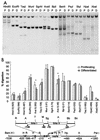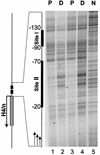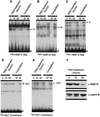Maintenance of open chromatin and selective genomic occupancy at the cell cycle-regulated histone H4 promoter during differentiation of HL-60 promyelocytic leukemia cells
- PMID: 12556504
- PMCID: PMC141140
- DOI: 10.1128/MCB.23.4.1460-1469.2003
Maintenance of open chromatin and selective genomic occupancy at the cell cycle-regulated histone H4 promoter during differentiation of HL-60 promyelocytic leukemia cells
Abstract
During the shutdown of proliferation and onset of differentiation of HL-60 promyelocytic leukemia cells, expression of the cell cycle-dependent histone genes is downregulated at the level of transcription. To address the mechanism by which this regulation occurs, we examined the chromatin structure of the histone H4/n (FO108, H4FN) gene locus. Micrococcal nuclease, DNase I, and restriction enzymes show similar cleavage sites and levels of sensitivity at the H4/n locus in both proliferating and differentiated HL-60 cells. In contrast, differentiation-related activation of the cyclin-dependent kinase inhibitor p21(cip1/WAF1) gene is accompanied by increased nuclease hypersensitivity. Chromatin immunoprecipitation assays of the H4/n gene reveal that acetylated histones H3 and H4 are maintained at the same levels in proliferating and postproliferative cells. Thus, the chromatin of the H4/n locus remains in an open state even after transcription ceases. Using ligation-mediated PCR to visualize genomic DNase I footprints at single-nucleotide resolution, we find that protein occupancy at the site II cell cycle element is selectively diminished in differentiated cells while the site I element remains occupied. Decreased occupancy of site II is reflected by loss of the site II binding protein HiNF-P. We conclude that H4 gene transcription during differentiation is downregulated by modulating protein interaction at the site II cell cycle element and that retention of an open chromatin conformation may be associated with site I occupancy.
Figures









Similar articles
-
Altered binding of human histone gene transcription factors during the shutdown of proliferation and onset of differentiation in HL-60 cells.Proc Natl Acad Sci U S A. 1989 Mar;86(6):1865-9. doi: 10.1073/pnas.86.6.1865. Proc Natl Acad Sci U S A. 1989. PMID: 2928309 Free PMC article.
-
Transcriptional induction of the osteocalcin gene during osteoblast differentiation involves acetylation of histones h3 and h4.Mol Endocrinol. 2003 Apr;17(4):743-56. doi: 10.1210/me.2002-0122. Epub 2003 Jan 9. Mol Endocrinol. 2003. PMID: 12554783
-
The integrated activities of IRF-2 (HiNF-M), CDP/cut (HiNF-D) and H4TF-2 (HiNF-P) regulate transcription of a cell cycle controlled human histone H4 gene: mechanistic differences between distinct H4 genes.Mol Biol Rep. 1998 Jan;25(1):1-12. doi: 10.1023/a:1006888731301. Mol Biol Rep. 1998. PMID: 9540062
-
Modifications in molecular mechanisms associated with control of cell cycle regulated human histone gene expression during differentiation.Cell Biophys. 1989 Dec;15(3):201-23. doi: 10.1007/BF02989684. Cell Biophys. 1989. PMID: 2480181 Review.
-
Control of cell cycle regulated histone genes during proliferation and differentiation.Int J Obes Relat Metab Disord. 1996 Mar;20 Suppl 3:S84-90. Int J Obes Relat Metab Disord. 1996. PMID: 8680483 Review.
Cited by
-
Mitotic retention of gene expression patterns by the cell fate-determining transcription factor Runx2.Proc Natl Acad Sci U S A. 2007 Feb 27;104(9):3189-94. doi: 10.1073/pnas.0611419104. Epub 2007 Feb 20. Proc Natl Acad Sci U S A. 2007. PMID: 17360627 Free PMC article.
-
G1 to S phase cell cycle transition in somatic and embryonic stem cells.J Anat. 2008 Jul;213(1):30-44. doi: 10.1111/j.1469-7580.2008.00931.x. J Anat. 2008. PMID: 18638068 Free PMC article. Review.
-
Auranofin promotes retinoic acid- or dihydroxyvitamin D3-mediated cell differentiation of promyelocytic leukaemia cells by increasing histone acetylation.Br J Pharmacol. 2008 Jul;154(6):1196-205. doi: 10.1038/bjp.2008.197. Epub 2008 May 26. Br J Pharmacol. 2008. PMID: 18500361 Free PMC article.
-
Genomic occupancy of HLH, AP1 and Runx2 motifs within a nuclease sensitive site of the Runx2 gene.J Cell Physiol. 2013 Feb;228(2):313-21. doi: 10.1002/jcp.22109. J Cell Physiol. 2013. PMID: 22886425 Free PMC article.
-
The architectural organization of human stem cell cycle regulatory machinery.Curr Pharm Des. 2012;18(13):1679-85. doi: 10.2174/138161212799859639. Curr Pharm Des. 2012. PMID: 22394165 Free PMC article. Review.
References
-
- Ausubel, F. M., R. Brent, R. E. Kingston, D. D. Moore, J. G. Seidman, J. A. Smith, and K. Struhl. 1997. Current protocols in molecular biology. John Wiley & Sons, New York, N.Y.
-
- Aziz, F., A. J. van Wijnen, P. S. Vaughan, S. Wu, A. R. Shakoori, J. B. Lian, K. J. Soprano, J. L. Stein, and G. S. Stein. 1998. The integrated activities of IRF-2 (HiNF-M) CDP/cut (HiNF-D) and H4TF-2 (HiNF-P) regulate transcription of a cell cycle controlled human histone H4 gene: mechanistic differences between distinct H4 genes. Mol. Biol. Rep. 25:1-12. - PubMed
-
- Baumbach, L. L., G. S. Stein, and J. L. Stein. 1987. Regulation of human histone gene expression: transcriptional and posttranscriptional control in the coupling of histone messenger RNA stability with DNA replication. Biochemistry 26:6178-6187. - PubMed
-
- Birnbaum, M. J., K. L. Wright, A. J. van Wijnen, A. L. Ramsey-Ewing, M. T. Bourke, T. J. Last, F. Aziz, B. Frenkel, B. R. Rao, N. Aronin, G. S. Stein, and J. L. Stein. 1995. Functional role for Sp1 in the transcriptional amplification of a cell cycle regulated histone H4 gene. Biochemistry 34:7648-7658. - PubMed
-
- Bulger, M., and M. Groudine. 1999. Looping versus linking: toward a model for long-distance gene activation. Genes Dev. 13:2465-2477. - PubMed
Publication types
MeSH terms
Substances
Grants and funding
LinkOut - more resources
Full Text Sources
